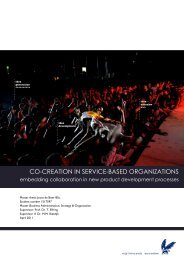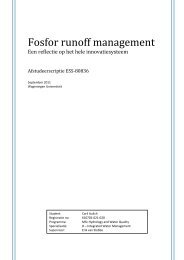Download PDF (Dutch) - Future Ideas
Download PDF (Dutch) - Future Ideas
Download PDF (Dutch) - Future Ideas
Create successful ePaper yourself
Turn your PDF publications into a flip-book with our unique Google optimized e-Paper software.
Summary English<br />
One of the objectives of the Water Framework Directive [WFD] is to achieve 'good ecological<br />
status' in surface water bodies. The relatively high concentrations of phosphorus in surface<br />
water are a limiting factor; despite the planned manure policy, 40-50% of the ditches and<br />
streams will probably not meet the target concentrations in 2027. Therefore, the government<br />
created a "WFD Innovationprogramme" to facilitate research into cost-effective innovations<br />
with which the standard could be achieved.<br />
Two projects from this WFD Innovation programme concern [measures with regard to] surface<br />
runoff. For a long time, the theory was adopted that the route of phosphate to the surface water<br />
was mainly through leaching from the soil. Only recently, research has shown that surface runoff<br />
could explain 10 to 70% of the load in surface water. It is possible that a reduction in phosphorus<br />
emissions can be achieved relatively easy and inexpensive by taking action on this transport<br />
route. A third project explores the extent to which iron-containing materials are suitable for<br />
adsorbing phosphate.<br />
This research project is an exploration of the technological innovation system [TIS] "phosphorus<br />
run-off management" in the Netherlands. It includes both the knowledge of the importance of<br />
this rapid transport route in the phosphorus load, and the possible measures against phosphorus<br />
emissions from surface run-off. The focus of this study is on the use of ferrous material as a<br />
measure for the reduction of phosphorus emissions.<br />
It is known that the diffusion of innovations is often difficult. More reflection on the entire<br />
innovation system is necessary. To obtain a complete picture of the TIS, it is described in various<br />
ways. With the innovation system approach, a snapshot of the innovation system is created,<br />
involving all elements of the TIS; actors, technology, actor networks and institutions are<br />
identified. Several aspects of the network [density and structure] are analyzed using insights<br />
from [social] network theory. To gain more insight into the development phase at this moment<br />
and what developments are currently needed for the innovation to continue to develop, an<br />
approach is used, which focuses on the processes that are important for well performing<br />
innovation systems. The diagnostic tool to describe the dynamics, is that of the seven innovation<br />
system functions.<br />
To examine the TIS, a large number of actors in the innovation system is interviewed:<br />
government, research institutes, suppliers and manufacturers, intermediate infrastructure, and<br />
potential users. The resulting data were combined with observations, literature review and<br />
insights from the above theories. The main findings of the study are shown below.<br />
Most actors consider phosphate as an essential nutrient, not immediately as an<br />
environmental problem. In general, when choosing measures that could reduce the runoff<br />
of phosphate, measures that ensure a “good soil structure” to facilitate infiltration are<br />
preferred, because the aim is also to have the phosphate available for the plant.<br />
Especially the scientists and the ZLTO are active actors in the TIS “phosphorus runoff<br />
management”; drinking water companies and Hego-Biotech, farmers and waterboards are<br />
involved as suppliers of ferrous materials or as sounding board. Consultancy Arcadis<br />
represents the intermediate infrastructure. The government plays a facilitating role by<br />
providing grants for the projects and in “Kennis moet stromen”. Education, agricultural<br />
advice and agribusiness, and nature and environmental organizations are not represented.<br />
The government had the ambition that in the course of 2012 the knowledge of the projects<br />
would have been spread to the end-users. This ambition may be too high. In this TIS the<br />
necessary knowledge has to be divided into three types:<br />
Reductie fosfaatafspoeling door ijzerhoudend materiaal Page 5





